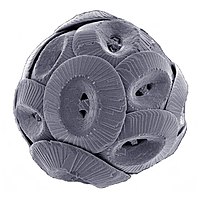
Bioerosion in fossil cephalopods: a case study from the Upper Carboniferous Buckhorn Asphalt Quarry Lagerstätte, Oklahoma, USA
Sign Up to like & getrecommendations! Published in 2019 at "Facies"
DOI: 10.1007/s10347-018-0547-y
Abstract: The mid-Pennsylvanian (Desmoinesian–Virgilian) deposits from the Buckhorn Asphalt Quarry Lagerstätte near Sulphur, Oklahoma, are characterized by siliciclastic–carbonate rocks. One of these deposits is the ‘cephalopod coquina’ that contains a large amount of orthocerid and coiled… read more here.
Keywords: quarry lagerst; bioerosion fossil; asphalt quarry; bioerosion ... See more keywords

Sponge bioerosion versus aqueous pCO2: morphometric assessment of chips and etching fissures
Sign Up to like & getrecommendations! Published in 2019 at "Facies"
DOI: 10.1007/s10347-019-0558-3
Abstract: Bioeroding sponges are important macroborers that chemically cut out substrate particles (chips) and mechanically remove them, thereby contributing to reef-associated sediment. These chemical and mechanical proportions vary with elevated levels of partial pressure of carbon… read more here.
Keywords: fissure width; sponge bioerosion; pco2; bioerosion ... See more keywords

Bioerosion ichnotaxa: review and annotated list
Sign Up to like & getrecommendations! Published in 2019 at "Facies"
DOI: 10.1007/s10347-019-0561-8
Abstract: AbstractA remarkable diversity of bioerosion trace fossils is reflected by the plethora of ichnotaxa that has been proposed for these structures during the past two centuries. Bioerosion traces include microborings, macroborings, grazing traces, attachment etchings,… read more here.
Keywords: bioerosion ichnotaxa; review annotated; bioerosion; annotated list ... See more keywords

Bioerosion and encrustation: Evidences from the Middle ‒ Upper Jurassic of central Saudi Arabia
Sign Up to like & getrecommendations! Published in 2017 at "Journal of African Earth Sciences"
DOI: 10.1016/j.jafrearsci.2017.07.016
Abstract: Abstract The Middle ‒ Upper Jurassic hard substrates of central Saudi Arabia displayed considerable signs of bioerosion and encrustations. They include organic (oysters, other bivalves, gastropods, corals and brachiopods) and an inorganic carbonate hardground that… read more here.
Keywords: bioerosion encrustation; upper jurassic; central saudi; middle upper ... See more keywords

A SEM-based assessment of bioerosion in Late Holocene faunal bone assemblages from the southern Pampas of Argentina
Sign Up to like & getrecommendations! Published in 2017 at "Journal of Archaeological Science: Reports"
DOI: 10.1016/j.jasrep.2017.07.012
Abstract: Over the last decades, research on microbial bioerosion affecting archaeological bone assemblages highlighted the fact that this is a significant factor determining the long-term survival of vertebrate hard tissues as well as the quality of… read more here.
Keywords: late holocene; southern pampas; bone; bioerosion ... See more keywords

Photosynthesis by symbiotic sponges enhances their ability to erode calcium carbonate
Sign Up to like & getrecommendations! Published in 2019 at "Journal of Experimental Marine Biology and Ecology"
DOI: 10.1016/j.jembe.2019.04.010
Abstract: Photosynthesis is an important driver of calcium carbonate deposition on tropical coral reefs largely due to the symbiosis of numerous invertebrates with photosynthetic dinoflagellates in the family Symbiodiniaceae. In bioeroding sponges, however, similar symbioses appear… read more here.
Keywords: calcium carbonate; ability; ecology; photosynthesis ... See more keywords

Bioerosion in shells from the Early Permian Rio Bonito Formation, Brazil: Taphonomic, paleobiological, and paleoecological implications
Sign Up to like & getrecommendations! Published in 2018 at "Palaeogeography, Palaeoclimatology, Palaeoecology"
DOI: 10.1016/j.palaeo.2018.06.003
Abstract: Abstract We report the occurrence of sponge borings in composite molds of heteropectinid shells from Early Permian marine siliciclastic deposits of the Parana Basin of southern Brazil. Sponge borings are preserved mainly as chambers (Entobia)… read more here.
Keywords: bioerosion shells; permian rio; bioerosion; early permian ... See more keywords

Light at the end of the tunnels? The origins of microbial bioerosion in mineralised collagen
Sign Up to like & getrecommendations! Published in 2019 at "Palaeogeography, Palaeoclimatology, Palaeoecology"
DOI: 10.1016/j.palaeo.2019.05.020
Abstract: Abstract Microbial bioerosion, in all its manifestations, is one of the major factors determining the long-term survival of archaeologically and environmentally important artefacts and ecofacts made from mineralised collagen – bones, antler, teeth and ivory.… read more here.
Keywords: bone; mineralised collagen; bioerosion; microbial bioerosion ... See more keywords

Bioerosion structures from the Pliocene of the Agua Amarga Subbasin (Almería, SE Spain): Palaeoecological and palaeoenvironmental implications
Sign Up to like & getrecommendations! Published in 2020 at "Palaeogeography, Palaeoclimatology, Palaeoecology"
DOI: 10.1016/j.palaeo.2020.110071
Abstract: Abstract The bioerosion trace fossils are described from the Pliocene cropping out at the Agua Amarga Subbasin (Betic Cordillera, Almeria Province, SE Spain). They are associated with limestone clasts (pebbles and cobbles) and molluscs constituting… read more here.
Keywords: agua amarga; bioerosion; bioerosion structures; amarga subbasin ... See more keywords

The influences of diurnal variability and ocean acidification on the bioerosion rates of two reef‐dwelling Caribbean sponges
Sign Up to like & getrecommendations! Published in 2022 at "Global Change Biology"
DOI: 10.1111/gcb.16442
Abstract: Ocean acidification (OA) is expected to modify the structure and function of coral reef ecosystems by reducing calcification, increasing bioerosion, and altering the physiology of many marine organisms. Much of our understanding of these relationships… read more here.
Keywords: reef; bioerosion rates; ocean acidification; bioerosion ... See more keywords

Assessment of the distribution of sponge chips in the sediment of East Pacific Ocean reefs
Sign Up to like & getrecommendations! Published in 2017 at "Marine Ecology"
DOI: 10.1111/maec.12390
Abstract: Sponges are one of the principal agents of bioerosion and sediment production in coral reefs. They generate small carbonate chips that can be found in the sediments, and we investigated whether these could provide a… read more here.
Keywords: sponge chips; sponge; chips sediment; sediment ... See more keywords